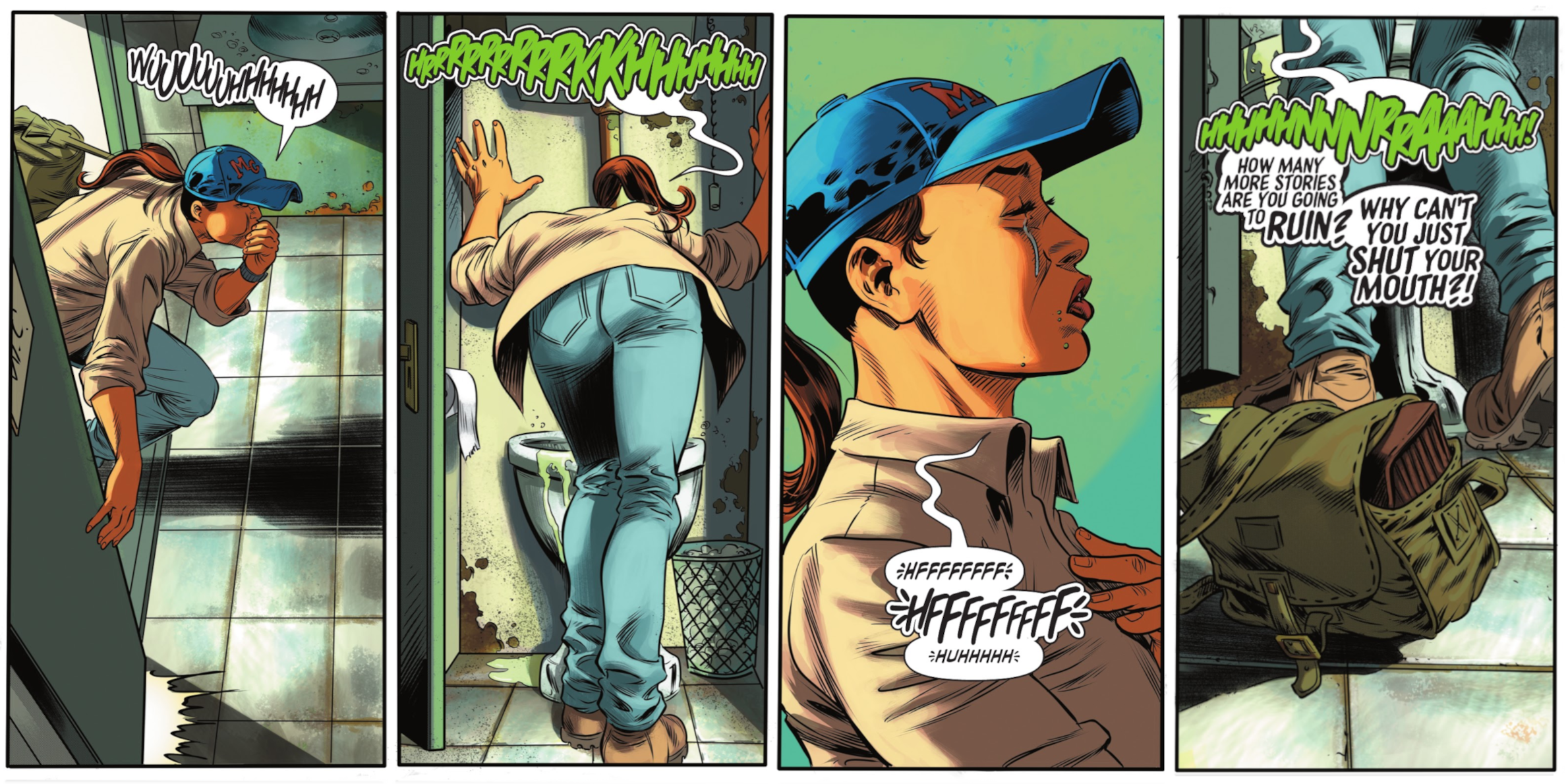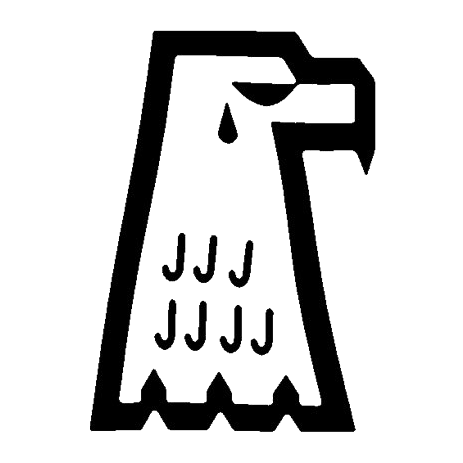My Life in No-Impact Journalism
The fourth-issue finale of WALLER VS. WILDSTORM is here. And this final behind-the-scenes post of mine will contain major spoilers, so read the issue first.

Edited by Sam Thielman
ONCE UPON A TIME, IN THE MEDIA CLIMATE OF THE MID-TO-LATE-2000s, the wealthy liberal donors activated by the Democratic Party against George W. Bush decided to save journalism. They had a specific idea about how they'd do it.
This idea had several variations, capable of fitting either for-profit or non-profit media. I'm just going to speak to the way I experienced it at a non-profit called the Washington Independent. Spoilers: the Washington Independent has not existed in more than a decade.
The Washington Independent was the flagship publication of something called the American Independent News Network (AINN). AINN was an attempt at mitigating the collapse of local journalism. It would build a network of state-focused websites, intended to one day spread to all 50 states, hiring experienced reporters and editors from declining local news outlets. The Colorado Independent was one of the first and best. We at what we called the Windy were to be their national bureau, producing national-focused pieces that could fit the sensibilities of the various state websites, and collaborating on local angles on national stories, as well as producing journalism for our own site. That meant hiring reporters who would focus on key beats of interest. One of them was "national security." I would work for $48,000 and health insurance, so they hired me.
So far, so good. But immediately there were certain visible flaws. If the point was local journalism, why was a national outlet the flagship? I started suspecting that this might not work out as planned when the guy in charge installed a treadmill desk before more than a handful of state sites had gone live.
About a year into the Washington Independent came the 2008 financial meltdown and Great Recession—something, thanks to the work of great journalists like Mary Kane, Annie Lowrey and Laura McGann, the Windy produced excellent journalism about. But it meant that the money began drying up before the infrastructure was built. And the donors, if they were going to keep funding a money-losing enterprise, wanted to see that they were getting something. They kept it civic-minded. These were liberals, after all; they would recoil at something as crude as telling a reporter what and how to report. Their goal—and, now, mine— was known to us as Impact Journalism.
What is Impact Journalism? we asked. Why, it's journalism that makes an impact, stupid.
OK, what counts as an impact? we continued. You'll be shocked to read that they wouldn't offer a clear answer.
An attempt at defining Impact Journalism eventually circulated from the top, and it was a paragraph-long muddle of evasions and aspirations. It left us so confused as to how our work would be evaluated that my colleagues made it into a t-shirt. But there was always one example of Impact Journalism that the AINN people would reach for: journalism that got a law passed or changed.
I can't overstate the panic that circulated through the newsroom when our collection of late-twenty-somethings and early-thirty-somethings heard that our jobs were to do journalism so… I don't know, unignorable?... as to change laws. While it may seem to the people who fund media networks that journalism should be able to do that, the overwhelming amount of journalism ever produced simply does not. Sometimes that testifies to the poor quality of the journalism in question. But usually it has more to do with what goes into making and changing laws. That process is not the mellifluous triumph of reason and rigor imagined by wealthy coastal liberal funders of journalism—the sort of people who see themselves as rescuing journalism, not influencing it.
As became obvious when AINN shut down 13 years ago, Impact Journalism had promised something it had no ability to deliver. Journalism is an enterprise that attracts out-of-control egos. But journalists who are here to do journalism have to experience a particular professional ego death. We have to accept that what we write won't change the horrors we exposed or bore witness to.
And here we finally arrive at the issue 4 finale of WALLER VS. WILDSTORM, my debut comic book miniseries for DC Comics, and the reason why Lois Lane has been here all along. Everything that follows is going to spoil the issue and the entire series. If this is something you care about, don't read on until you've finished WALLER VS. WILDSTORM! And if you're interested in WALLER VS. WILDSTORM but aren't paying for FOREVER WARS, you'll want to fix that now, because in two weeks, I'm going to paywall this post. Don't miss out—I feel pretty confident that when you're done with WALLER VS. WILDSTORM you'll be interested in me discussing it!
IT SO HAPPENS that against all odds I have been involved in journalism that got a law changed. That happened in 2015, when after two years and an arduous legislative battle opposed by the intelligence agencies and Barack Obama, Congress stopped the NSA's warrantless bulk collection of Americans' phone records. So that's what it takes to do Impact Journalism: Edward Snowden, and then two years. By the way, not only did the law that got passed not apply to the vast majority of bulk NSA surveillance, it collapsed in failure within three years.
My only other example that might count as Impact Journalism also happened after I left the Washington Independent. In 2011, at WIRED, I exposed a counterterrorism training course for junior FBI special agents at Quantico that instructed them to target American Muslims as an internal threat to national security. That reporting got Obama to make the FBI junk hundreds of pages of FBI training materials. No laws got changed, but I got the attention of the proto-MAGA Islamophobic right. By 2013, Robert Spencer, a leading writer and activist on the "counterjihadist" circuit—whose work was extensively cited by the far-right terrorist and mass murderer of children Anders Breivik—said I bore responsibility for the Boston Marathon bombing, by blinding the FBI from the threat of Islam.
A couple years later, I exposed a warehouse called Homan Square where police in Chicago would literally disappear people for hours and even overnight before formally booking them. That placed them out of reach of their families and attorneys, and at the mercy of the police. People died in those conditions. In something that still gives me chills when I remember it, Chicagoans occupied the area diagonally adjacent to the warehouse complex for 41 days in 2016, renaming it Freedom Square. But Homan Square remains open for business to this day.
Even the greatest journalists can't control their impact. The best book ever written about Henry Kissinger is Seymour Hersh's The Price of Power. (Greg Grandin agrees.) Whatever you think about late-career Hersh, he's someone who has done more than his share of Impact Journalism, and that book is justly a classic. But when it came time for Hersh to eulogize Kissinger, he testified to how little an impediment even his classic biography proved to Kissinger's reputation. "He’d have to be caught with a knife in his hand, blood dripping from it, and the body still twitching to ever suffer consequences for his actions," Hersh wrote in his newsletter. (Stay for a killer Scotty Reston anecdote.) Not even one of the greatest reporters of his age was able to produce the One Story that could slay Henry Kissinger.
So I wouldn't be telling the truth if I had Lois Lane, the avatar of journalism in DC Comics—maybe even in pop culture, period?—produce the One Story that could slay Amanda Waller.
THERE'S NO OTHER REPORTER WHO COULD. Across 85 years of publication history, it feels like every story Lois publishes is a career-making revelation. It's routine for her to foil the plans of political and economic supervillains, particularly those of the tech/science oligarch Lex Luthor. She collects Pulitzers, and never off cheap or frivolous pieces. She's who the funders of the American Independent News Network were expecting us to be. When I had Jackson King tell her in issue 1, "Fuck you, Lois Lane," that's what I was channeling, however different the context.
I knew from the start that Lois wasn't going to do any Impact Journalism in DC/WildStorm’s Pacific island dictatorship, Gamorra. In my headcanon—and it is just that, so please do not put this in Lois Lane's Wikipedia—WALLER VS. WILDSTORM is the story of Lois Lane's first Pulitzer. (Doing an Amanda Waller year-one let me backdoor-pilot my Lois year-one. You get two year-ones for the price of one year-one!) She'll get professional acclaim, prestige within the Daily Planet newsroom and with any luck even some internal validation. But Yumiko Gamorra still runs that island and Adeline Kane got promoted. Reader, it happened to me!
None of this means journalism is powerless. It means that when journalism actually confronts power, power is arrayed in such a way that it will not shatter upon impact with journalism. Power would not be power were it not resilient. To approach journalism through its least representative examples of efficacy—Watergate; in a more ambiguous case, Edward Snowden—is to set an impossible expectation that will inevitably lead to a doomerist conception of journalistic impotence. Worse, it's to misunderstand power. History is not changed by one damning, irrefutable story that burns away avarice through the force of its proof. History is changed by enough people standing together against power until power cannot withstand them.
And journalism can inspire them to stand together. Not through the myth of impact. But through the force of bearing witness—as demonstrated every excruciating day of heroism from Plestia, Bisan, Motaz, Hind, Wael al-Dahdouh and all Gaza's endangered journalists. General Rong, the leader of the Gamorran resistance, loses. But Lois is able to tell the world why she led that resistance in the first place. There's a reason why Deathstroke, after blowing up Battalion's hotel suite in issue 3, tells Amanda and Adeline, "just say it was a gas leak." It's the same reason that Deathstroke tells them that it's a "big fucking mistake" to stop him from killing Lois. Without journalism, reality is what Deathstroke, Amanda and Adeline say it is. Except that the people of Gamorra, however silenced at the moment, know that power is presenting them with a lie they are expected to accept.
As Kaizen Gamorra says in issue 4, the people of Gamorra will never stay conquered. One day, Lois' expose will be part of their collective memory of struggle. It will reinforce to them that reality was not what their leaders insisted. That collective memory, the old conqueror Kaizen is acknowledging, will one day overpower Yumiko and her American patrons. Adeline doesn't get that. Her line after the Senate hearing, about how maybe Lois would have stopped them if she wrote the story the way Jackson wanted, shows she's thinking in the mistaken terms of Impact Journalism. (The specific line I gave her resulted from me speaking the language of my anxiety dreams.)
When the people overpower Yumiko, Lois will not be responsible for it; the people will. But what Lois revealed will be part of how the people came to triumph.
That is what journalism can be: not a stone that spiders the facade of power until it cracks apart, but a tile in a mosaic of righteousness.
Or, if you'll allow me, a brick in the Wall.
I'M GOING TO BE FOREVER GRATEFUL to the WALLER VS. WILDSTORM team, starting with my friend Evan Narcisse, who properly taught me how to write comics. I strongly recommend making comics with your (extremely talented) pals.
But also I loved working with Jesús Merino, Vicente Cifuentes, Michael Atiyeh, Dave Sharpe and my new friend Eric Battle. I can't believe how incredible our covers are—Jorge Fornés defined our look and feel, and was aided by everyone from classic StormWatch artist Tom Raney, Mike Perkins, Aaron Campbell and Alvaro Fernandez Bueno. I had no idea Alvaro was doing a cover for us until I went over to his New York Comic Con table and gushed over The Nice House on The Lake. I gave him the first three issues of WVW out of respect, expecting him never to have heard of it, and he took out his phone to show me his issue 4 variant, a typically gorgeous Deathstroke-Lois composition. I also truly can't believe I got to work with a veteran superhero storyteller like Jesús – let alone for my first-ever comic.
This book could not have happened with crucial support from DC, from assistant editor Marquis Draper to editor-in-chief Marie Javins—and the living legend Jim Lee, who did something for me I'll cherish for the rest of my life. Above all, WALLER VS. WILDSTORM happened because its editor, Chris Conroy, believed in this story, and believed in me, someone who never wrote a comic book. Chris is an exceptional person and an elite-tier craftsman of an editor. I can't say enough good things about him, and about everyone else who was part of WALLER VS. WILDSTORM—which includes you, the reader.
This was a lot of fun, and I think we delivered a well-crafted book that said something. I'd sure like to write more comic books, if anyone reading this far into the newsletter has any power to make that happen. AIPT gave it a 9 out of 10 and said: "Waller vs. Wildstorm has been a unique corner of superhero comics this year and has been a pleasure to review. Comics newcomer Spencer Ackerman is welcome back any time." Sounds auspicious!
IF YOU'D LIKE TO ORDER A COMPLETE SET of WALLER VS. WILDSTORM, signed by me and containing a certificate of authenticity, click over to Bulletproof Comics. This is the only way to get the whole miniseries in time for the holidays! I just signed a bunch more issue-2s and issue-1s, but supplies will not last! And if you're in the NYC area, I'll be signing at Bulletproof on Saturday, Dec. 16 from 4pm to 6pm, so come hang out.
WALLER VS. WILDSTORM will be collected in trade paperback in January 2024. I'd love it if you preordered that as well. You'll get some behind-the-scenes stuff in the collection, as well as a whole new essay by me. And if you'd like to read my notes on the previous issues, they're here, here and here.
AS WE WERE PUTTING THIS ISSUE TOGETHER, my old colleague Rachel Weiner, now of the Washington Post, tweeted that I seem to have had my work cited by Donald Trump's attorneys. And here I am out here talking about not having an impact.

